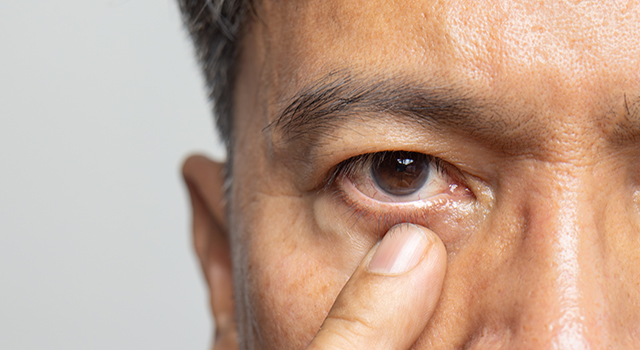
Although the name sounds really weird, a pinguecula is actually pretty common. First of all, if you’re wondering how to say it – pinguecula is pronounced pin-GWEK-yoo-la. Too difficult to say aloud? Another easier name for this condition is “surfer’s eye.”
It is a bump or yellowish patch on the eyeball that occurs when there are changes to the conjunctiva of the eye. The conjunctiva, a thin membrane that covers the white part of your eye, is normally clear – but pingueculae make it appear as a yellow-tinged deposit of fat, protein or calcium. Typically, this patch appears on the side of the eye near the nose.
Along with the characteristic yellow bump, symptoms of pinguecula may include eye irritation, dryness, itching, inflammation, and redness in the eye. If you experience these symptoms or notice them in your child, book an eye exam at one of our eye care centers in Lewis Center, Westerville, Johnstown, or , Ohio. That’s the only reliable way to get a diagnosis of pinguecula in kids and adults.
What causes a pinguecula?
Eye irritation caused by sun exposure, wind and dust has been linked to the changes in conjunctiva tissue that lead to a pinguecula. (Now you understand why this eye problem earned the nickname of “surfer’s eye.”) While this eye condition is more common in adults, it can occur at any age – it’s not rare for our eye doctor to diagnose a pinguecula in kids.
How can you prevent a pinguecula?
If you or your kids spend a lot of time outdoors, it increases your risks. A few steps can be taken to help prevent the development of these yellow bumps in your eye.
- Protect your eyes from the sun and dust by wearing sunglasses with 100% UV protection; wraparound designs are best.
- Keep your eyes moist, especially in dry environments, by using artificial tears eye drops.
What is the treatment for pingueculae?
How to treat pingueculae depends largely on whether you have a minor case or a more serious condition that is affecting your vision. If your symptoms are mild, pinguecula treatment may consist of eye drops or ointments. When a pinguecula is close to the cornea, causes extreme discomfort, affects the aesthetic appearance of your eye, or makes it impossible to wear contact lenses comfortably, surgical removal (less common) may be indicated. Our eye doctors in Lewis Center, Westerville, Johnstown, and Northeast Columbus can diagnose the severity of pinguecula and determine the most appropriate treatment with an eye exam.
Do pinguecula grow or worsen with time?
Often, pingueculae can cause pterygia to develop. These are wing-shaped, fibrovascular growths of tissue that appear on the white of the eye. Pterygia can spread onto the cornea and disturb your vision. Steroid eye drops or lubricants may be prescribed as treatment, or surgical removal may be necessary for more serious cases. They contain blood vessels and are very noticeable, so many people prefer surgical removal, when recommended.
+To learn more about pingueculae and pterygia from our eye doctors in Lewis Center, Westerville, Johnstown, and Northeast Columbus, Ohio read about this eye condition here.
At Professional VisionCare, we put your family’s needs first. Talk to us about how we can help you maintain healthy vision. Call us today: 614-898-9989 or book an appointment online to see one of our Lewis Center eye doctors.
Want to Learn More? Read on!
FOLLOW US:































